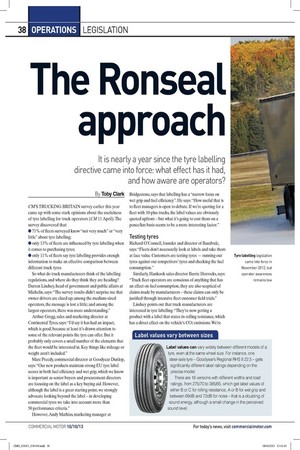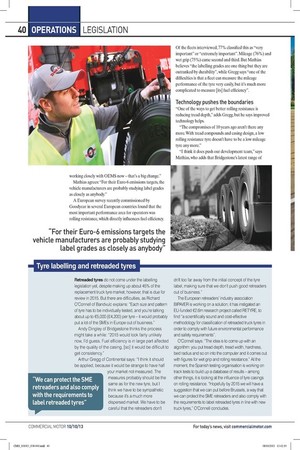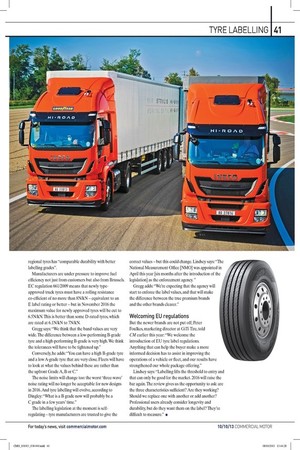The Ronseat approach
Page 32

Page 34

Page 35

If you've noticed an error in this article please click here to report it so we can fix it.
It is nearly a year since the tyre labelling directive came into force: what effect has it had, and how aware are operators? By Toby Clark CM'S TRUCKING BRITAIN survey earlier this year came up with some stark opinions about the usefulness of tyre labelling for truck operators (CM 11 April). The survey discovered that: • 71% of fleets surveyed know "not very much" or "very little" about tyre labelling; • only 13% of fleets are influenced by tyre labelling when it comes to purchasing tyres;
• only 11% of fleets say tyre labelling provides enough information to make an effective comparison between different truck tyres.
So what do truck manufacturers think of the labelling regulations, and where do they think they are heading? Darren Lindsey, head of government and public affairs at Michelin, says: "The survey results didn't surprise me that owner drivers are clued up; among the medium-sized operators, the message is lost a little; and among the largest operators, there was more understanding."
Arthur Gregg, sales and marketing director at Continental Tyres, says: "I'd say it has had an impact, which is good, because at least it's drawn attention to some of the relevant points the tyre can offer. But it probably only covers a small number of the elements that the fleet would be interested in. Key things like mileage or weight aren't included."
Marc Preedy, commercial director at Goodyear Dunlop, says: "Our new products maintain strong EU tyre label scores in both fuel efficiency and wet grip, which we know is important as senior buyers and procurement directors are focusing on the label as a key buying aid. However, although the label is a great starting point, we strongly advocate looking beyond the label — in developing commercial tyres we take into account more than 50 performance criteria." However, Andy Mathias, marketing manager at
Bridgestone, says that labelling has a "narrow focus on wet grip and fuel efficiency". He says: "How useful that is to fleet managers is open to debate. If we're quoting for a fleet with 10-plus trucks, the label values are obviously quoted upfront — but what it's going to cost them on a pence/km basis seems to be a more interesting factor."
Testing tyres
Richard O'Connell, founder and director of Bandvulc, says: "Fleets don't necessarily look at labels and take them at face value. Customers are testing tyres — running our tyres against our competitors' tyres and checking the fuel consumption."
Similarly, Hankook sales director Barrie Horrocks, says: "Truck fleet operators are conscious of anything that has an effect on fuel consumption, they are also sceptical of claims made by manufacturers — these claims can only be justified through intensive fleet customer field trials." Lindsey points out that truck manufacturers are interested in tyre labelling. "They're now getting a product with a label that states its rolling resistance, which has a direct effect on the vehicle's CO2 emissions. We're
working closely with OEMS now — that's a big change."
Mathias agrees: "For their Euro-6 emissions targets, the vehicle manufacturers are probably studying label grades as closely as anybody."
A European survey recently commissioned by Goodyear in several European countries found that the most important performance area for operators was rolling resistance, which directly influences fuel efficiency.
Of the fleets interviewed, 77% classified this as "very important" or "extremely important". Mileage (76%) and wet grip (75%) came second and third. But Mathias believes "the labelling grades are one thing but they are outranked by durability", while Gregg says "one of the difficulties is that a fleet can measure the mileage performance of the tyre very easily, but it's much more complicated to measure [its] fuel efficiency".
Technology pushes the boundaries
"One of the ways to get better rolling resistance is reducing tread depth," adds Gregg, but he says improved technology helps.
"The compromises of 10 years ago aren't there any more. With tread compounds and casing design, a low rolling resistance tyre doesn't have to be a low mileage tyre any more." "I think it does push our development team," says Mathias, who adds that Bridgestone's latest range of
regional tyres has "comparable durability with better labelling grades".
Manufacturers are under pressure to improve fuel efficiency not just from customers but also from Brussels. EC regulation 661/2009 means that newly typeapproved truck tyres must have a rolling resistance co-efficient of no more than 8N/kN — equivalent to an E label rating or better — but in November 2016 the maximum value for newly approved tyres will be cut to 6.5N/kN. This is better than some D-rated tyres, which are rated at 6.1N/kN to 7N/kN.
Gregg says: "We think that the band values are very wide. The difference between a low-performing B-grade tyre and a high-performing B-grade is very high. We think the tolerances will have to be tightened up."
Conversely, he adds: "You can have a high B-grade tyre and a low A-grade tyre that are very close. Fleets will have to look at what the values behind these are rather than the upfront Grade A, B or C."
The noise limits will change too: the worst 'three-wave' noise rating will no longer be acceptable for new designs in 2016. And tyre labelling will evolve, according to Dingley: "What is a B grade now will probably be a C grade in a few years' time." The labelling legislation at the moment is selfregulating — tyre manufacturers are trusted to give the correct values — but this could change. Lindsey says: "The National Measurement Office [NMO] was appointed in April this year [six months after the introduction of the
legislation] as the enforcement agency.
Gregg adds: "We're expecting that the agency will start to enforce the label values, and that will make the difference between the true premium brands and the other brands clearer."
Welcoming EU regulations
But the newer brands are not put off; Peter Foulkes, marketing director at GiTi Tire, told CM earlier this year: "We welcome the introduction of EU tyre label regulations.
Anything that can help the buyer make a more informed decision has to assist in improving the operations of a vehicle or fleet, and our results have strengthened our whole package offering." Lindsey says: "Labelling lifts the threshold to entry and that can only be good for the market. 2016 will raise the bar again. The review gives us the opportunity to ask: are the three characteristics sufficient? Are they working? Should we replace one with another or add another? Professional users already consider longevity and durability, but do they want them on the label? They're difficult to measure." •









































